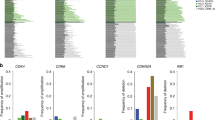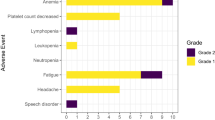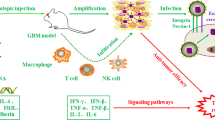Abstract
Glioblastoma (GBM) is the most common primary brain tumor in adults and has a dismal prognosis despite multimodality treatment. Given the resistance of glioma stem cells (GSC) to chemotherapy and radiation therapy, their eradication could prevent tumor recurrence. We sought to evaluate the antitumor activity of measles virus (MV) derivatives against GSC. We generated neurosphere cultures from patient-derived primary tumor GBM xenografts, and we characterized them for the GSC markers CD133, SOX2, Nestin, ATF5 and OLIG2. Using the MV-strains MV-GFP, MV-CEA and MV-NIS we demonstrated infection, viral replication and significant cytopathic effect in vitro against GSC lines. In tumorigenicity experiments, GBM44 GSC were infected with MV in vitro and subsequently implanted into the right caudate nucleus of nude mice: significant prolongation of survival in mice implanted with infected GSC was observed, compared with mock-infected controls (P=0.0483). In therapy experiments in GBM6 and GBM12 GSC xenograft models, there was significant prolongation of survival in MV-GFP-treated animals compared with inactivated virus-treated controls (GBM6 P=0.0021, GBM12 P=0.0416). Abundant syncytia and viral replication was demonstrated in tumors of MV-treated mice. Measles virus derivatives have significant antitumor activity against glioma-derived stem cells in vitro and in vivo.
This is a preview of subscription content, access via your institution
Access options
Subscribe to this journal
Receive 12 print issues and online access
$259.00 per year
only $21.58 per issue
Buy this article
- Purchase on Springer Link
- Instant access to full article PDF
Prices may be subject to local taxes which are calculated during checkout







Similar content being viewed by others
References
Siegel R, Ward E, Brawley O, Jemal A . Cancer statistics, 2011: the impact of eliminating socioeconomic and racial disparities on premature cancer deaths. CA: a Cancer Journal for Clinicians 2011; 61: 212–236.
Alcantara Llaguno S, Chen J, Kwon CH, Jackson EL, Li Y, Burns DK et al. Malignant astrocytomas originate from neural stem/progenitor cells in a somatic tumor suppressor mouse model. Cancer cell 2009; 15: 45–56.
Bao S, Wu Q, Sathornsumetee S, Hao Y, Li Z, Hjelmeland AB et al. Stem cell-like glioma cells promote tumor angiogenesis through vascular endothelial growth factor. Cancer Res 2006; 66: 7843–7848.
Chen R, Nishimura MC, Bumbaca SM, Kharbanda S, Forrest WF, Kasman IM et al. A hierarchy of self-renewing tumor-initiating cell types in glioblastoma. Cancer Cell 2010; 17: 362–375.
Allen C, Paraskevakou G, Liu C, Iankov ID, Msaouel P, Zollman P et al. Oncolytic measles virus strains in the treatment of gliomas. Expert Opinion Biol Ther 2008; 8: 213–220.
Paraskevakou G, Allen C, Nakamura T, Zollman P, James CD, Peng KW et al. Epidermal growth factor receptor (EGFR)-retargeted measles virus strains effectively target EGFR- or EGFRvIII expressing gliomas. Mol Ther 2007; 15: 677–686.
Phuong LK, Allen C, Peng KW, Giannini C, Greiner S, TenEyck CJ et al. Use of a vaccine strain of measles virus genetically engineered to produce carcinoembryonic antigen as a novel therapeutic agent against glioblastoma multiforme. Cancer Res 2003; 63: 2462–2469.
Dingli D, Peng KW, Harvey ME, Greipp PR, O'Connor MK, Cattaneo R et al. Image-guided radiovirotherapy for multiple myeloma using a recombinant measles virus expressing the thyroidal sodium iodide symporter. Blood 2004; 103: 1641–1646.
Msaouel P, Iankov ID, Allen C, Morris JC, von Messling V, Cattaneo R et al. Engineered measles virus as a novel oncolytic therapy against prostate cancer. Prostate 2009; 69: 82–91.
Peng KW, Facteau S, Wegman T, O'Kane D, Russell SJ . Non-invasive in vivo monitoring of trackable viruses expressing soluble marker peptides. Nature Med 2002; 8: 527–531.
Carlson BL, Pokorny JL, Schroeder MA, Sarkaria JN . Establishment, maintenance and in vitro and in vivo applications of primary human glioblastoma multiforme (GBM) xenograft models for translational biology studies and drug discovery. Curr Protocols Pharm/editorial board, S.J. Enna 2011; Chapter 14: Unit 14 16.
Giannini C, Sarkaria JN, Saito A, Uhm JH, Galanis E, Carlson BL et al. Patient tumor EGFR and PDGFRA gene amplifications retained in an invasive intracranial xenograft model of glioblastoma multiforme. Neuro Oncol 2005; 7: 164–176.
Stupp R, Mason WP, van den Bent MJ, Weller M, Fisher B, Taphoorn MJ et al. Radiotherapy plus concomitant and adjuvant temozolomide for glioblastoma. N Engl J Med 2005; 352: 987–996.
Beier D, Hau P, Proescholdt M, Lohmeier A, Wischhusen J, Oefner PJ et al. CD133(+) and CD133(-) glioblastoma-derived cancer stem cells show differential growth characteristics and molecular profiles. Cancer Res 2007; 67: 4010–4015.
Hambardzumyan D, Squatrito M, Holland EC . Radiation resistance and stem-like cells in brain tumors. Cancer Cell 2006; 10: 454–456.
Liu Q, Nguyen DH, Dong Q, Shitaku P, Chung K, Liu OY et al. Molecular properties of CD133+ glioblastoma stem cells derived from treatment-refractory recurrent brain tumors. J Neuro-oncol 2009; 94: 1–19.
Murat A, Migliavacca E, Gorlia T, Lambiv WL, Shay T, Hamou MF et al. Stem cell-related ‘self-renewal’ signature and high epidermal growth factor receptor expression associated with resistance to concomitant chemoradiotherapy in glioblastoma. J Clin Oncol 2008; 26: 3015–3024.
Sakariassen PO, Immervoll H, Chekenya M . Cancer stem cells as mediators of treatment resistance in brain tumors: status and controversies. Neoplasia 2007; 9: 882–892.
Ying M, Wang S, Sang Y, Sun P, Lal B, Goodwin CR et al. Regulation of glioblastoma stem cells by retinoic acid: role for Notch pathway inhibition. Oncogene 2011; 30: 3454–3467.
Kanai R, Wakimoto H, Martuza RL, Rabkin SD . A novel oncolytic herpes simplex virus that synergizes with phosphoinositide 3-kinase/akt pathway inhibitors to target glioblastoma stem cells. Clin Cancer Res 2011; 17: 3686–3696.
Wakimoto H, Kesari S, Farrell CJ, Curry WT, Zaupa C, Aghi M et al. Human glioblastoma-derived cancer stem cells: establishment of invasive glioma models and treatment with oncolytic herpes simplex virus vectors. Cancer Res 2009; 69: 3472–3481.
Dhiman N, Jacobson RM, Poland GA . Measles virus receptors: SLAM and CD46. Rev Med Virol 2004; 14: 217–229.
Yanagi Y, Takeda M, Ohno S. . Measles virus: cellular receptors, tropism and pathogenesis. J Gen Virol 2006; 87: 2767–2779.
Schneider U, von Messling V, Devaux P, Cattaneo R . Efficiency of measles virus entry and dissemination through different receptors. J Virol 2002; 76: 7460–7467.
Yanagi Y . The cellular receptor for measles virus. Uirusu 2001; 51: 201–208.
Ulasov IV, Tyler MA, Zheng S, Han Y, Lesniak MS . CD46represents a target for adenoviral gene therapy of malignant glioma. Hum Gene Ther 2006; 17: 556–564.
Adams EM, Brown MC, Nunge M, Krych M, Atkinson JP . Contribution of the repeating domains of membrane cofactor protein (CD46) of the complement system to ligand binding and cofactor activity. J Immunol 1991; 147: 3005–3011.
Fishelson Z . Complement C3: a molecular mosaic of binding sites. Mol Immunol 1991; 28: 545–552.
Oglesby TJ, White D, Tedja I, Liszewski K, Wright L, Van den Bogarde J et al. Protection of mammalian cells from complement-mediated lysis by transfection of human membrane cofactor protein and decay-accelerating factor. Trans Assoc Am Phys 1991; 104: 164–172.
Galanis E, O'Neill BP, Piepgras D, Meyer FB, Uhm JH, Marks R et al. Phase I intratumoral and resection cavity administration of a measles virus derivative expressing the human carcionembroyonic antigen (CEA) in patients with recurrent glioblastoma multiforme. (Abstract MA-15). Neuro-Oncology 2008; 10: 819.
Muhlebach MD, Mateo M, Sinn PL, Prufer S, Uhlig KM, Leonard VH et al. Adherens junction protein nectin-4 is the epithelial receptor for measles virus. Nature 2011; 480: 530–533.
Derycke MS, Pambuccian SE, Gilks CB, Kalloger SE, Ghidouche A, Lopez M et al. Nectin 4 overexpression in ovarian cancer tissues and serum: potential role as a serum biomarker. Am J Clin Pathol 2010; 134: 835–845.
Fabre-Lafay S, Garrido-Urbani S, Reymond N, Goncalves A, Dubreuil P, Lopez M . Nectin-4, a new serological breast cancer marker, is a substrate for tumor necrosis factor-alpha-converting enzyme (TACE)/ADAM-17. J Biol Chem 2005; 280: 19543–19550.
Takano A, Ishikawa N, Nishino R, Masuda K, Yasui W, Inai K et al. Identification of nectin-4 oncoprotein as a diagnostic and therapeutic target for lung cancer. Cancer Res 2009; 69: 6694–6703.
Togashi H, Sakisaka T, Takai Y . Cell adhesion molecules in the central nervous system. Cell Adh Migr 2009; 3: 29–35.
Giannini C, Sarkaria JN, Saito A, Uhm JH, Galanis E, Carlson BL et al. Patient tumor EGFR and PDGFRA gene amplifications retained in an invasive intracranial xenograft model of glioblastoma multiforme. Neuro-oncology 2005; 7: 164–176.
Msaouel P, Iankov ID, Allen C, Aderca I, Federspiel MJ, Tindall DJ et al. Noninvasive imaging and radiovirotherapy of prostate cancer using an oncolytic measles virus expressing the sodium iodide symporter. Mol Ther 2009; 17: 2041–2048.
Acknowledgements
This study was supported by NIH Grants R01 CA 154348 and NIH P50 CA 108961.
Author information
Authors and Affiliations
Corresponding author
Ethics declarations
Competing interests
The authors declare no conflict of interest.
Additional information
Supplementary Information accompanies the paper on Gene Therapy website
Supplementary information
Rights and permissions
About this article
Cite this article
Allen, C., Opyrchal, M., Aderca, I. et al. Oncolytic measles virus strains have significant antitumor activity against glioma stem cells. Gene Ther 20, 444–449 (2013). https://doi.org/10.1038/gt.2012.62
Received:
Revised:
Accepted:
Published:
Issue Date:
DOI: https://doi.org/10.1038/gt.2012.62
Keywords
This article is cited by
-
Association between viral infections and glioma risk: a two-sample bidirectional Mendelian randomization analysis
BMC Medicine (2023)
-
Self-replicating vehicles based on negative strand RNA viruses
Cancer Gene Therapy (2023)
-
Emerging therapies for glioblastoma: current state and future directions
Journal of Experimental & Clinical Cancer Research (2022)
-
Oncolytic Viral Therapy for Malignant Glioma and Their Application in Clinical Practice
Neurotherapeutics (2022)
-
Self-assembled Viral Nanoparticles as Targeted Anticancer Vehicles
Biotechnology and Bioprocess Engineering (2021)



